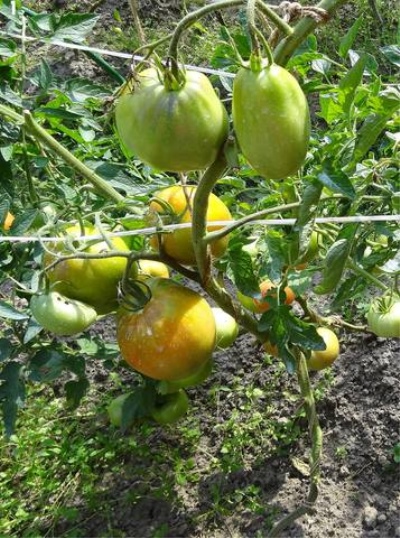
- Year of approval: 2007
- Category: grade
- Growth type: indeterminate
- Appointment: universal
- Ripening period: mid-season
- Growing conditions: for open ground, for film greenhouses
- Bush height, cm: 150-180
- Leaves: large, dark green
- Unripe fruit color: green with a dark green spot at the stalk
- Ripe fruit color: Red
The Siberian miracle tomato is one of the many domestic varieties, in which vegetable growers have discovered a lot of advantages. Tomatoes, which give a high yield of tasty fruits, intended for cold regions, are loved by gardeners of the northern regions.
Breeding history
Altai scientists began work on the breeding of this type of tomato in the last decade of the last century, in 2007 the novelty was registered by the State Register of Breeding Varieties. The initially set task - to achieve stable high yields for areas with difficult natural conditions - has been fulfilled. The tests were successful, the results correspond to the description presented. The variety is unpretentious in care, the fruits are applied fresh, suitable for harvesting.
Description of the variety
Belongs to indeterminate, tall crops with a powerful stem, they require additional support, which are long stakes or trellises. Tomato clusters support the weight of the fruit without tying. Weather conditions do not affect the formation of ovaries, allowing you to always give a beautiful, fragrant, tasty harvest.
The simplicity of agricultural technology, other positive qualities make it possible to cultivate tomatoes in personal household plots, dachas and farms.
The main qualities of the fruit
Large oval tomatoes with a ribbed structure. Some specimens of the first brushes weigh up to 200 g, they have a bright crimson color. The variety is distinguished by the fact that the tomatoes do not crack. For transportation, they are removed a little immature.
Taste characteristics
In any climate, in different weather conditions, juicy, fleshy, sweet tomatoes with a slight sourness of an amazing taste grow. Filmed mature, the former are consumed fresh, the subsequent ones are used for pickling and preparing various snacks, lecho, adjika. According to doctors, tomatoes contain serotonin, a hormone that improves mood.
Ripening and fruiting
The plant bears fruit for a long time, the brushes ripen gradually, the harvest pleases even experienced gardeners. Unripe tomatoes reach the condition indoors, while maintaining consumer properties. A variety of medium ripening.
Yield
In greenhouses from 1 sq. m, up to 8-10 kg of tomatoes are harvested, 2-4 kg are removed from one bush. On the beds, the harvest looks more modest, especially if the weather was unfavorable. Ground tomatoes have the best taste and aroma. This yield is considered high.
The timing of planting seedlings and planting in the ground
Seeds, aged in a pink solution of potassium permanganate (potassium permanganate) and treated with a growth stimulant, are planted in boxes in mid-March, taking into account the germination region and favorable days of the lunar calendar. For tomatoes, only the seedling method of growing is suitable. When seedlings appear, the plants are exposed to light, watered as needed, no fertilizing is used. For planting, they take fertile garden land or buy a ready-made peat-based substrate. Then the seedlings are dived into separate plastic cups with holes at the bottom for water drainage. Before transplanting to the beds, the plants are taken outside for several days for adaptation.

Growing tomato seedlings is an extremely important process, because it largely depends on whether the gardener will be able to harvest at all. All aspects must be taken into account, from seedbed preparation to planting in the ground.
Landing scheme
In the open field, 2 bushes are planted per 1 sq. m, 4 pieces are placed under cover on this area. Be sure to install long stakes or make support for the stems. The main stem is left on the tomato without stepchildren. If this is not done, the yield will decrease.

Growing and care
The agrotechnics are as follows: moderate watering, several fertilizers as needed, weed removal, regular loosening of the soil, timely cutting of stepchildren. Plants in the greenhouse are systematically ventilated, the vents are opened. The variety does not like overheating, if it is combined with high air humidity, the plants can get sick with a fungal infection. In the fall, with a sharp cold snap, tomatoes are removed immature, laid out at home so that they can sing, the quality and taste are preserved.




A plant needs different micronutrients at each stage of growth. All fertilizers can be divided into two groups: mineral and organic. Folk remedies are often used: iodine, yeast, bird droppings, eggshells.
It is important to observe the rate and period of feeding. This also applies to folk remedies and organic fertilizers.
Disease and pest resistance
On plants, although rarely, brown rot appears, which can damage the crop. For treatment, drugs for fungal infection are used, they are also treated with bushes when infected with dry spot. The affected fruits are destroyed, they stop using fertilizers with nitrogen, and the amount of watering is reduced. If whitefly and rusty tick larvae are found on tomatoes, they are sprayed with insecticides. After the appearance of the ovaries, the use of chemicals is stopped.


Resistant to adverse weather conditions
The variety, bred for cultivation in difficult meteorological conditions, copes with the task: it grows and bears fruit with sudden changes in temperature and humidity in any climate. Subject to simple agrotechnical measures, a good harvest of delicious tomatoes is regularly harvested.
Growing regions
The tomato is suitable for all climatic zones of the Russian Federation. In the regions of risky vegetable growing, it is grown under shelters, in the southern regions, in open-air beds.
The Siberian miracle tomato is grown by experienced and novice gardeners. If you follow these planting and care tips, they both get a good quality crop.

























































































